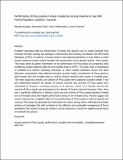Performance of Pinus patula in Areas Invaded by Acacia mearnsii in Sao Hill Forest Plantation, Southern Tanzania

View/
Date
2020-07-06Author
Kingazi, Nanyika
Petro, Revocatus
Mbwambo, John
Munishi, Linus
Metadata
Show full item recordAbstract
Problems associated with the invasiveness of exotic tree species such as Acacia mearnsii have increased recently causing vast damage in environment and economy worldwide. Sao Hill Forest Plantation (SHFP) in southern Tanzania which is the potential plantation in East Africa is under Acacia mearnsii invasion which threatens the productivity of the planted species, Pinus patula. This study aimed to gather information on the performance of Pinus patula by comparing areas invaded by Acacia mearnsii with the non-invaded areas in SHFP. The study used a combination of stratified and random sampling techniques to select sample plantation blocks and plots allocation, respectively. Data collected included survival, height, and diameter of Pinus patula in both invaded and non-invaded areas as well as Acacia mearnsii stem counts in invaded areas. The mean basal area, density, and volume of Pinus patula were subjected to paired sample T-test and relationship between the density of Acacia mearnsii and survival of Pinus patula were established by Pearson’s correlation analysis in R software version 3.5.2. Results showed that survival of Pinus patula was decreasing as the density of Acacia mearnsii increased. Also, there was a significant difference in density, basal area and volume of Pinus patula between invaded and non-invaded areas with higher performance being in non-invaded areas. Results suggest that Acacia mearnsii has a negative effect on the performance of Pinus patula in both its growth and survival. This study has generated the information for which among others will help to formulate policies and strategies that will contribute to the effective and sustainable management of forest plantations that should incorporate invasive control measures to avoid the negative performance of desirable tree species.
URI
https://doi.org/10.1080/10549811.2020.1788952https://dspace.nm-aist.ac.tz/handle/20.500.12479/2228
